A Destriping Algorithm for SDGSAT-1 Nighttime Light Images Based on Anomaly Detection and Spectral Similarity Restoration
Abstract
1. Introduction
- The characteristics of the stripe are analyzed and summarized. The bright stripe factor sequence (BSFS) and the dark stripe factor sequence (DSFS) are defined to locate the bright stripe and the dark stripe in the GI image, respectively.
- A spectral-similarity-based method is introduced to restore the stripe in the GI image, which considers the spectral similarity between pixels and has a better restoring effect of the stripe in the GI image compared with other restoration methods.
- The ADSSR algorithm is proposed to effectively restore stripes for the GI image, which provides a feasible method to improve the quality of the GI image.
- The residual noise entropy (RNE) is defined to quantify the destriping performance, which provides a new quantitative evaluator for destriping the GI image.
2. Data Analysis
2.1. Image Characteristics Analysis
2.2. Stripes Characteristics Analysis
- (1)
- The bright stripe
- (2)
- The dark stripe
3. Methods
3.1. Pretreatment
| Algorithm 1. Salt-pepper noise suppression |
| Input: SDGSAT-1 GI original image original_img |
| 1: Transform original_img into a binary image with 0 as the threshold binary_img 2: Calculate the connected component of binary_img connected_component_set 3: Set the minimum area threshold of connected_component th 4: for connected_component in connected_component_set: 5: Calculate the area of connected_component tmp_area 6: if tmp_area < th: 7: connected_component is labeled as the salt-pepper noises 8: All labeled connected_component constitute the salt-pepper noise mask 9: Mask treatment to filter salt-pepper noise of original_img Output: SDGSAT-1 GI preprocessed image pre_img |
3.2. Stripe Detection
3.2.1. Bright Stripe Detection
| Algorithm 2. Bright stripe detection |
| Input: SDGSAT-1 GI preprocessed image pre_img |
| 1: Convert pre_img into a binary image with 0 as the threshold binary_img 2: Sum each column of binary_img to get an original sequence original_seq 3: Set the median smoothing step size ms_step 4: reference_seq = median(original_seq, ms_step) 5: BSFS = original_seq/(reference_seq + 1) 6: Set the threshold of the valid pixel number, and the threshold of the bright stripe factor. th1, th2 7: Calculate the column number N of binary_img 8: Create an empty list bs_col_list to record the column index of the bright stripe 9: for i in range(N): 10: if original_seq[i] > th1 and BSFS[i] > th2: 11: bs_col_list.append(i) Output: The column index list of the bright stripe bs_col_list |
3.2.2. Dark Stripe Detection
| Algorithm 3. Dark stripe detection |
| Input: SDGSAT-1 GI preprocessed image pre_img |
| 1: Sum each column of pre_img to obtain an original sequence original_seq 2: Set the median smoothing step size ms_step 3: reference_seq = median(original_seq, ms_step) 4: DSFS = original_seq/(reference_seq + 1) 5: Set the threshold of the valid pixel number, and the threshold of the dark stripe factor. th1, th2 6: Calculate the column number N of pre_img 7: Create an empty list ds_col_list to record the column index of the dark stripe 8: for i in range(N): 9: Calculate the valid pixel number ni in column i 10: if ni > th1 and DSFS[i] < th2: 11: bs_col_list.append(i) Output: The column index list of the dark stripe ds_col_list |
3.2.3. Abnormal Pixel Estimation
| Algorithm 4. Abnormal pixel estimation |
| Input: The column vector of the stripe stripe_vector |
| 1: Estimate the stationary sequence S_sta based on DBSCAN algorithm [34] 2: Calculate the threshold to identify abnormal pixels T_est by Equation (4) 3: Calculate the length L of stripe_vector 4: Create an empty list ap_row_list to record the row index of abnormal pixels 5: for i in range(L): 5: if stripe_vector[i]<T_est: 6 ap_row_list.append(i) Output: The row index list of abnormal pixels ap_row_list |
3.3. Stripe Restoration
| Algorithm 5. Stripe restoration. |
| Input: The multispectral image ms_img |
| 1: Suppress the salt-pepper noise by Algorithm 1 pre_ms_img 2: Assume band 1 of pre_ms_img is unrestored 3: b1_img = pre_ms_img[:,:,0], b2_img = pre_ms_img[:,:,1], b3_img = pre_ms_img[:,:,2] 4: Obtain the column index list of bright stripes bs_col_list in b1_img by Algorithm 2 5: Obtain the column index list of dark stripes ds_col_list in b1_img by Algorithm 3 6: Merge bs_col_list and ds_col_list stripe_col_list 7: for col in stripe_col_list: 8: s_vector =b1_img[:,col] 9: Obtain the row index list of abnormal pixels ap_row_list by Algorithm 4 10: left_col = col + 1 11: right_col = col−1 12: while(left_col in stripe_col_list): 13: left_col = left_col + 1 14: while(right_col in stripe_col_list): 15: right_col = right_col + 1 16: ref_data = hstack(pre_ms_img[:,left_col,:], pre_ms_img[:,right,:]) 17: for row in ap_row_list: 18: ap_ spectral_vector =pre_ms_img[row,col,:] 19: ns_spectral_vector_set = ref_data[row−1:row + 2,:,:] 20: Initial i0 = 0, j0 = 0, d0 = 10e6 20: for i in range(2): 21: for j in range(3): 22: ns_spectral_vector = ns_spectral_vector_set[i,j,:] 23: Calculate the Euclidean distance tmp_d by Equation (5) 25: if tmp_d < d0: 26: d0 = tmp_d, i0 = i, j0 = j 27: pre_ms_img[row,col,0] = ns_spectral_vector_set[i0,j0,0] Output: b1_img with stripe restoration |
4. Experiment and Results
4.1. Experiments Details
4.1.1. Comparative Experiment
4.1.2. Full-Size Images Experiment
4.2. Experiments Results
4.2.1. Results of Comparative Experiment
4.2.2. Results of Full-Size Images Experiment
5. Discussion
- The salt-pepper noise in the GI image is suppressed using the area threshold of the connected component, which may lose some information with respect to artificial lights with areas that are less than the threshold, especially in rural areas where artificial lights are scarce.
- When the impact scale of some road lights is less than the minimum observation capacity of the SDGSAT-1, the width of these roads on the image is often no more than one pixel. In this case, if a stripe appears on this kind of road and the direction of the road is consistent with the stripe, the stripe’s restoration will lose some information (Figure 13). Although this situation is rare, it is still noteworthy.
- 3.
- The ADSSR algorithm is mainly based on subjective characteristics of images and stripes. Although it is applicable to most images, the subjective characteristics of images and stripes cannot perfectly summarize the actual characteristics in the case of complex weather conditions and poor original image quality, so the performance of the ADSSR algorithm will be degraded. As shown in Figure 14, a cloudy image with invalid relative radiometric correction parameters is selected for testing. Although most of the stripes can be removed, the residual stripe noise is more obvious than that of the cloudless image. Fortunately, the availability of such images is not high.
6. Conclusions
Author Contributions
Funding
Data Availability Statement
Acknowledgments
Conflicts of Interest
References
- Levin, N.; Kyba, C.C.; Zhang, Q.; De Miguel, A.S.; Román, M.O.; Li, X.; Portnov, B.A.; Molthan, A.L.; Jechow, A.; Miller, S.D.; et al. Remote sensing of night lights: A review and an outlook for the future. Remote Sens. Environ. 2020, 237, 111443. [Google Scholar] [CrossRef]
- Grinand, C.; Rakotomalala, F.; Gond, V.; Vaudry, R.; Bernoux, M.; Vieilledent, G. Estimating deforestation in tropical humid and dry forests in Madagascar from 2000 to 2010 using multi-date Landsat satellite images and the random forests classifier. Remote Sens. Environ. 2013, 139, 68–80. [Google Scholar] [CrossRef]
- Masolele, R.N.; Sy, V.N.; Herold, M.; Marcos, D.; Verbesselt, J.; Gieseke, F.; Mullissa, A.G.; Martius, C. Spatial and temporal deep learning methods for deriving land-use following deforestation: A pan-tropical case study using Landsat time series. Remote Sens. Environ. 2021, 264, 112600. [Google Scholar] [CrossRef]
- Smith, V.; Portillo-Quintero, C.; Sanchez-Azofeifa, A.; Hernandez-Stefanoni, J.L. Assessing the accuracy of detected breaks in Landsat time series as predictors of small scale deforestation in tropical dry forests of Mexico and Costa Rica. Remote Sens. Environ. 2019, 221, 707–721. [Google Scholar] [CrossRef]
- Dixit, M.; Chaurasia, K.; Mishra, V.K. Dilated-ResUnet: A novel deep learning architecture for building extraction from medium resolution multi-spectral satellite imagery. Expert Syst. Appl. 2021, 184, 115530. [Google Scholar] [CrossRef]
- Zhang, X.; Cheng, B.; Chen, J.; Liang, C. High-Resolution Boundary Refined Convolutional Neural Network for Automatic Agricultural Greenhouses Extraction from GaoFen-2 Satellite Imageries. Remote Sens. 2021, 13, 4237. [Google Scholar] [CrossRef]
- Yang, Y.; Wu, J.; Wang, Y.; Huang, Q.; He, C. Quantifying spatiotemporal patterns of shrinking cities in urbanizing China: A novel approach based on time-series nighttime light data. Cities 2021, 118, 103346. [Google Scholar] [CrossRef]
- Chen, T.K.; Prishchepov, A.V.; Fensholt, R.; Sabel, C.E. Detecting and monitoring long-term landslides in urbanized areas with nighttime light data and multi-seasonal Landsat imagery across Taiwan from 1998 to 2017. Remote Sens. Environ. 2019, 225, 317–327. [Google Scholar] [CrossRef]
- Zhu, E.; Qi, Q.; Chen, L.; Wu, X. The spatial-temporal patterns and multiple driving mechanisms of carbon emissions in the process of urbanization: A case study in Zhejiang, China. J. Clean. Prod. 2022, 358, 131954. [Google Scholar] [CrossRef]
- Zhang, G.; Guo, X.; Li, D.; Jiang, B. Evaluating the Potential of LJ1-01 Nighttime Light Data for Modeling Socio-Economic Parameters. Sensors 2019, 19, 1465. [Google Scholar] [CrossRef]
- Jiang, W.; He, G.; Liu, H.; Ni, Y. Modelling China economic parameters based on DMSP/OLS nighttime light imagery. Remote Sens. Inf. 2018, 33, 29. [Google Scholar] [CrossRef]
- Elvidge, C.D.; Safran, J.; Tuttle, B.; Sutton, P.; Cinzano, P.; Pettit, D. Potential for global mapping of development via a Nightsat mission. GeoJournal 2007, 69, 45–53. [Google Scholar] [CrossRef]
- Jiang, W.; He, G.; Long, T.; Wang, C.; Ni, Y.; Ma, R. Assessing Light Pollution in China Based on Nighttime Light Imagery. Remote Sens. 2017, 9, 135. [Google Scholar] [CrossRef]
- Jiang, W.; He, G.; Leng, W.; Long, T.; Wang, G.; Liu, H.; Peng, Y.; Yin, R.; Guo, H. Characterizing Light Pollution Trends across Protected Areas in China Using Nighttime Light Remote Sensing Data. ISPRS Int. J. Geo-Inf. 2018, 7, 243. [Google Scholar] [CrossRef]
- Bauer, S.E.; Wagner, S.; Burch, J.B.; Bayakly, R.; Vena, J.E. A case-referent study: Light at night and breast cancer risk in Georgia. Int. J. Health Geogr. 2013, 12, 23. [Google Scholar] [CrossRef]
- Wei, S.; Jiao, W.; Long, T.; Liu, H.; Bi, L.; Jiang, W.; Portnov, B.A.; Liu, M. A Relative Radiation Normalization Method of ISS Nighttime Light Images Based on Pseudo Invariant Features. Remote Sens. 2020, 12, 3349. [Google Scholar] [CrossRef]
- Guo, H.; Chen, H.; Chen, L.; Fu, B. Progress on CASEarth Satellite Development. Chin. J. Space Sci. 2020, 40, 707–717. [Google Scholar] [CrossRef]
- Chen, J.; Cheng, B.; Zhang, X.; Long, T.; Chen, B.; Wang, G.; Zhang, D. A TIR-Visible Automatic Registration and Geometric Correction Method for SDGSAT-1 Thermal Infrared Image Based on Modified RIFT. Remote Sens. 2022, 14, 1393. [Google Scholar] [CrossRef]
- Wang, B.; Bao, J.; Wang, S.; Wang, H.; Sheng, Q. Improved Line Tracing Methods for Removal of Bad Streaks Noise in CCD Line Array Image—A Case Study with GF-1 Images. Sensors 2017, 17, 935. [Google Scholar] [CrossRef]
- Xie, Y.; Wang, J.; Shang, K. An improved approach based on Moment Matching to Destriping for Hyperion data. Procedia Environ. Sci. 2011, 10, 319–324. [Google Scholar] [CrossRef][Green Version]
- Li, M.; Nong, S.; Nie, T.; Han, C.; Huang, L.; Qu, L. A Novel Stripe Noise Removal Model for Infrared Images. Sensors 2022, 22, 2971. [Google Scholar] [CrossRef] [PubMed]
- Han, T.; Goodenough, D.G.; Dyk, A. Detection and Correction of Abnormal Pixels in Hyperion Images. In Proceedings of the IEEE International Geoscience & Remote Sensing Symposium, Toronto, ON, Canada, 24–28 June 2002; Volume 3, pp. 1327–1330. [Google Scholar] [CrossRef]
- Shen, Y.; Liu, X.; Wu, L.; Su, H.; He, H. A Local Spectral-spatial Similarity Measure for Bad Line Correction in Hyperion Hyperspectral Data. Geomat. Inf. Sci. Wuhan Univ. 2017, 42, 99–101. [Google Scholar] [CrossRef]
- Erkan, U.; Gökrem, L.; Enginoğlu, S. Different applied median filter in salt and pepper noise. Comput. Electr. Eng. 2018, 70, 789–798. [Google Scholar] [CrossRef]
- Rasal, T.; Veerakumar, T.; Subudhi, B.N.; Esakkirajan, S. A new approach for reduction of the noise from microscopy images using Fourier decomposition. Biocybern. Biomed. Eng. 2022, 42, 615–629. [Google Scholar] [CrossRef]
- Moradi, M. Wavelet transform approach for denoising and decomposition of satellite-derived ocean color time-series: Selection of optimal mother wavelet. Adv. Space Res. 2022, 69, 2724–2744. [Google Scholar] [CrossRef]
- Wang, C.; Zhang, Y.; Wang, X.; Ji, S. Stripe noise removal of remote image based on wavelet variational method. Acta Geod. Cartogr. Sin. 2019, 48, 1025–1037. [Google Scholar] [CrossRef]
- Pande-Chhetri, R.; Abd-Elrahman, A. De-striping hyperspectral imagery using wavelet transform and adaptive frequency domain filtering. ISPRS J. Photogramm. 2011, 66, 620–636. [Google Scholar] [CrossRef]
- Wang, J.; Huang, T.; Zhao, X.; Huang, J.; Ma, T.; Zheng, Y. Reweighted Block Sparsity Regularization for Remote Sensing Images Destriping. IEEE J. Sel. Top. Appl. Earth Observ. Remote Sens. 2019, 12, 4951–4963. [Google Scholar] [CrossRef]
- Ladjal, S.; Bouali, M. Toward Optimal Destriping of MODIS Data Using a Unidirectional Variational Model. IEEE Trans. Geosci. Remote Sens. 2011, 49, 2924–2935. [Google Scholar] [CrossRef]
- Zhao, S.; Li, J.; Hu, Y.; Liu, X.; Zhang, L. A Fast and Effective Irregular Stripe Removal Method for Moon Mineralogy Mapper (M3). IEEE Trans. Geosci. Remote Sens. 2022, 60, 4600119. [Google Scholar] [CrossRef]
- Chen, Y.; Huang, T.; Zhao, X. Destriping of Multispectral Remote Sensing Image Using Low-Rank Tensor Decomposition. IEEE J. Sel. Top. Appl. Earth Observ. Remote Sens. 2018, 11, 4950–4976. [Google Scholar] [CrossRef]
- Chambolle, A. An algorithm for total variation minimization and applications. J. Math. Imaging Vis. 2004, 20, 89–97. [Google Scholar] [CrossRef]
- Cui, H.; Wu, W.; Zhang, Z.; Han, F.; Liu, Z. Clustering and application of grain temperature statistical parameters based on the DBSCAN algorithm. J. Stored Prod. Res. 2021, 93, 101819. [Google Scholar] [CrossRef]
- Cao, Y.; Yang, M.; Tisse, C. Effective Strip Noise Removal for Low-Textured Infrared Images Based on 1-D Guided Filtering. IEEE Trans. Circuits Syst. Video Technol. 2016, 26, 2176–2188. [Google Scholar] [CrossRef]
- Chang, S.; Yu, B.; Vetterli, M. Adaptive wavelet thresholding for image denoising and compression. IEEE Trans. Image Process. 2000, 9, 2176–2188. [Google Scholar] [CrossRef] [PubMed]
- Donoho, D.; Johnstone, I. Ideal spatial adaptation by wavelet shrinkage. Biometrika 1994, 81, 425–455. [Google Scholar] [CrossRef]

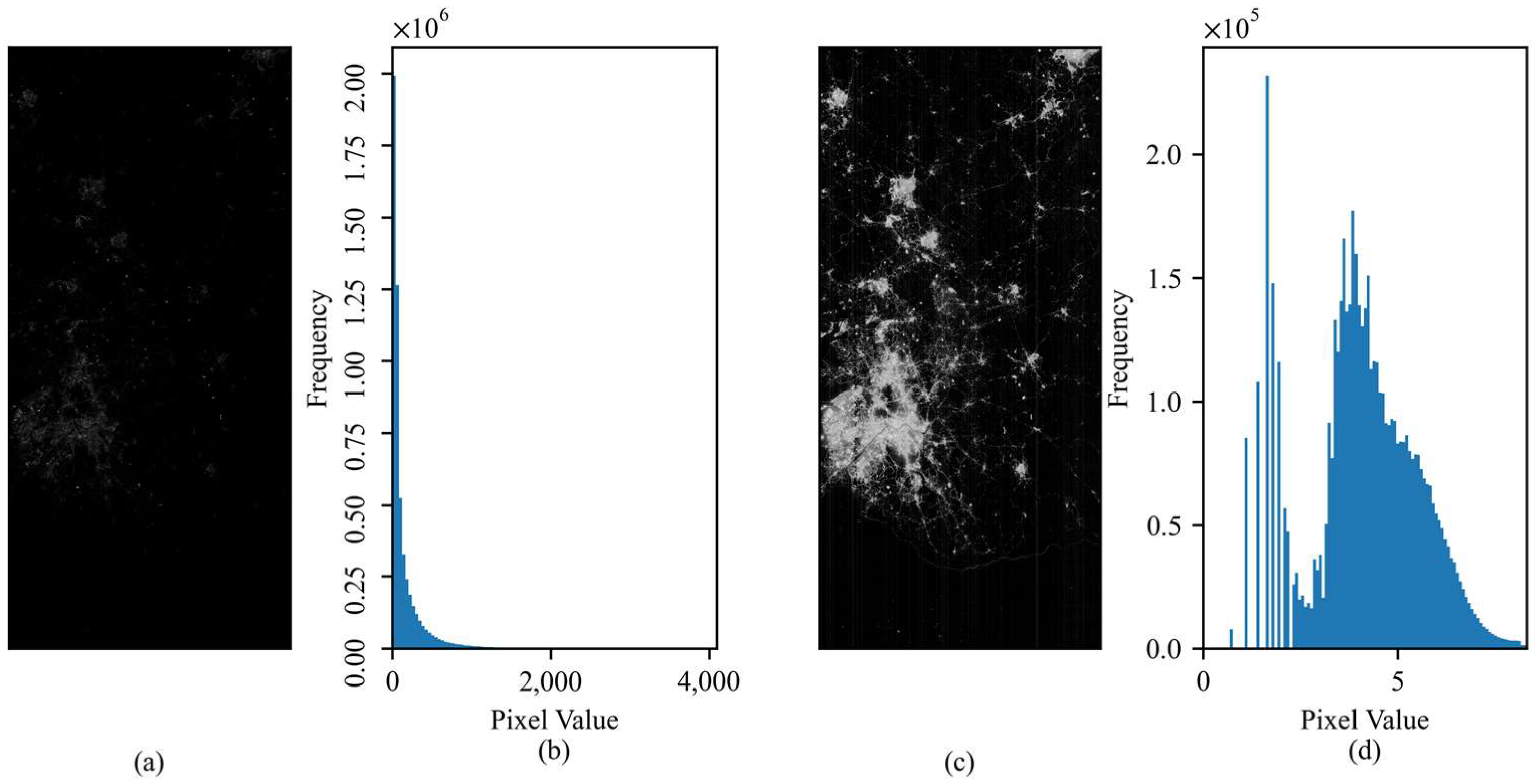
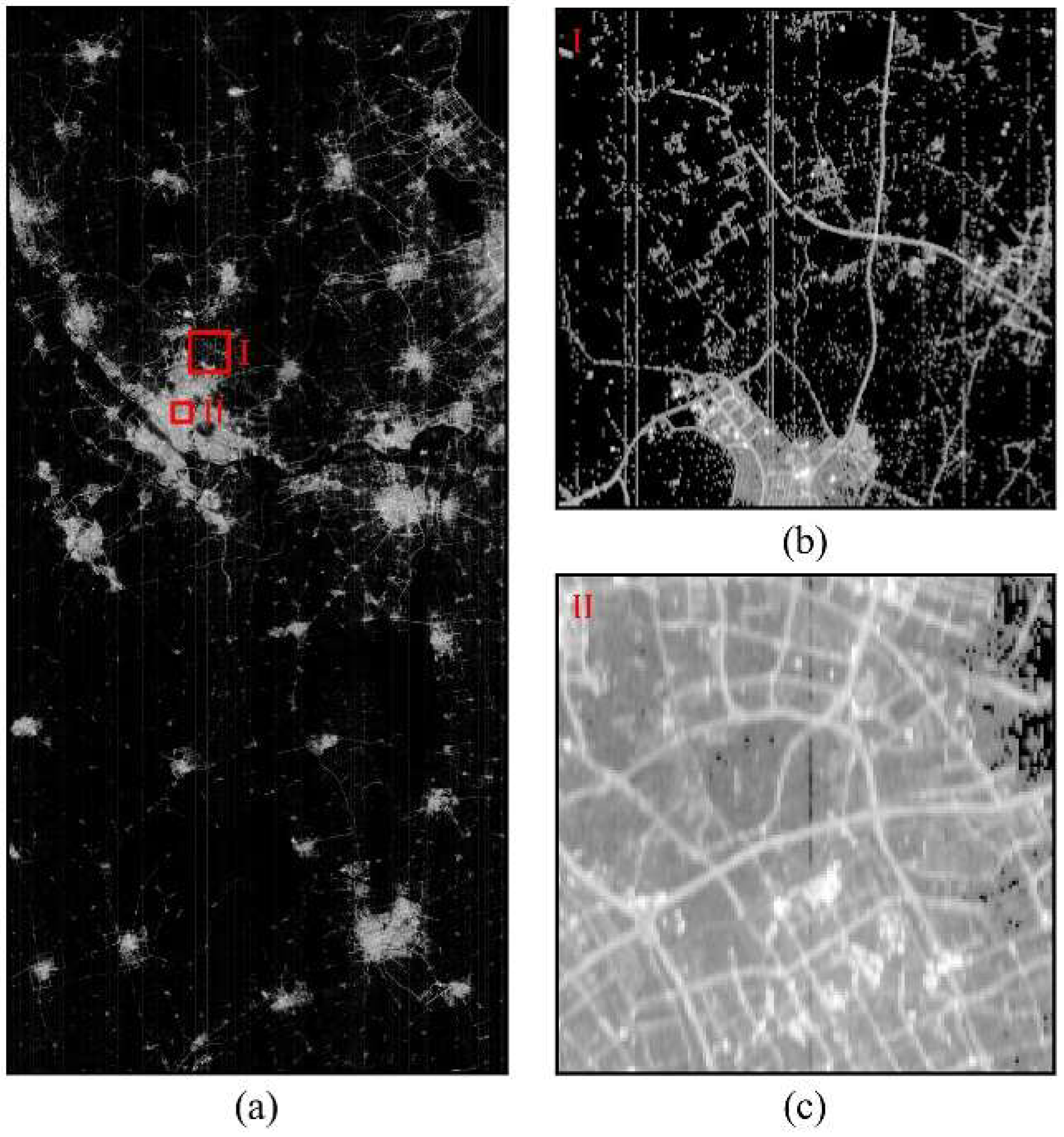
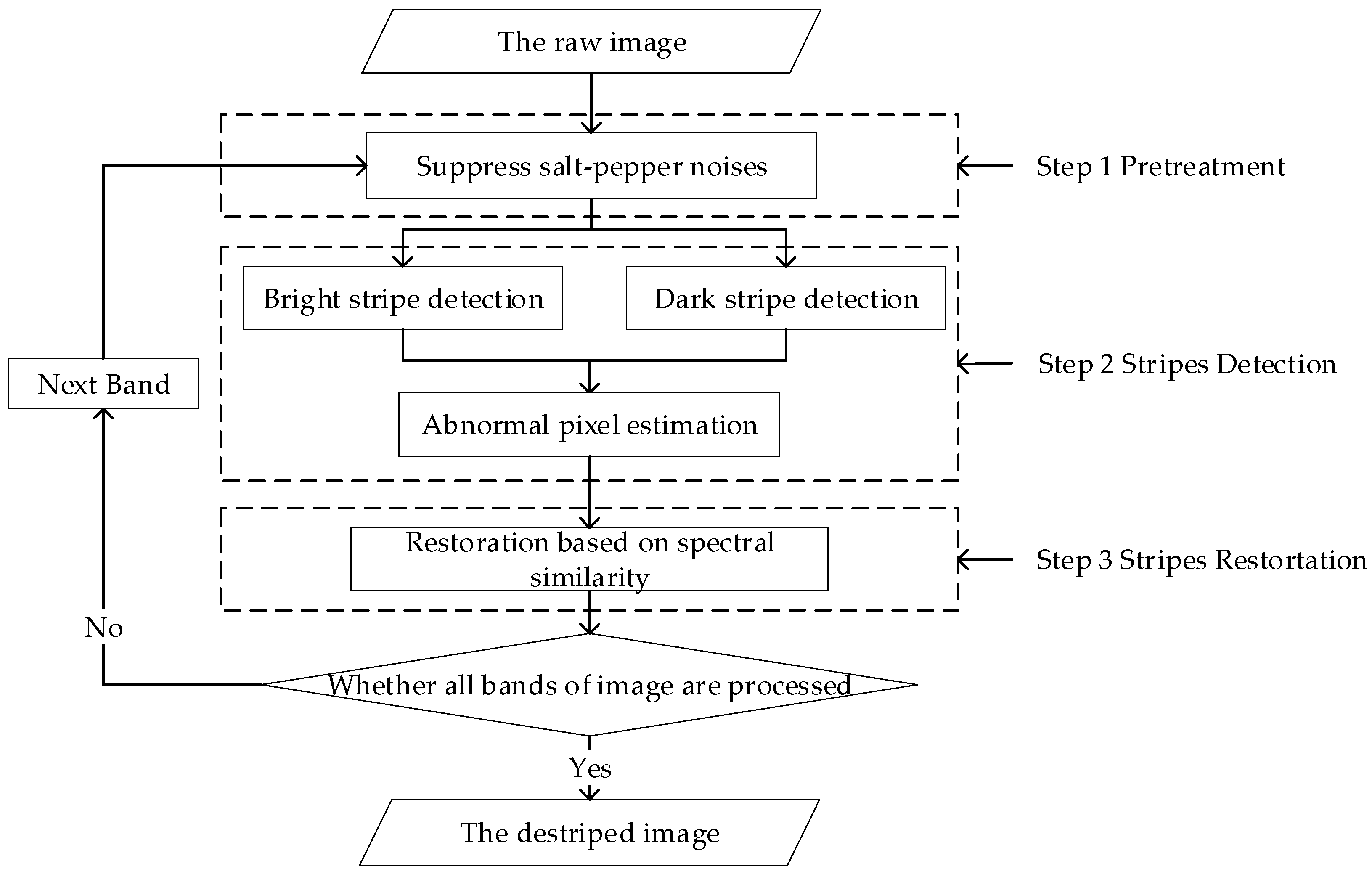
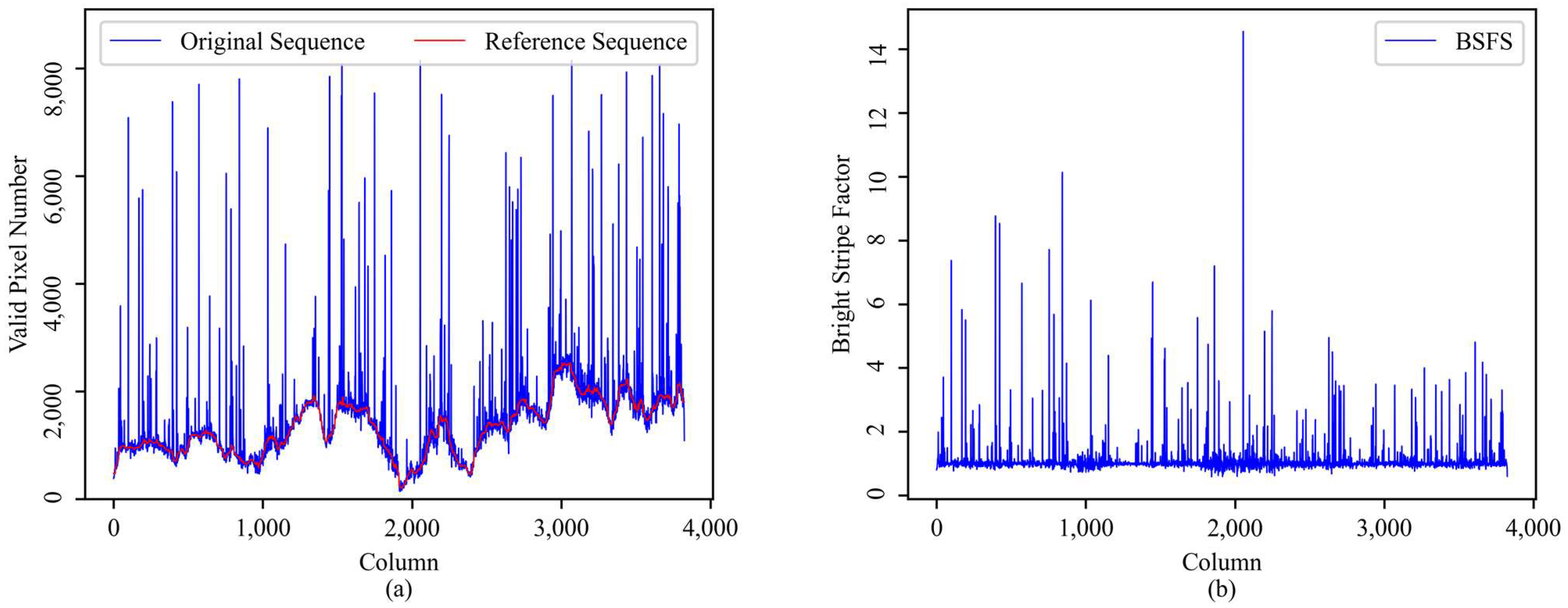
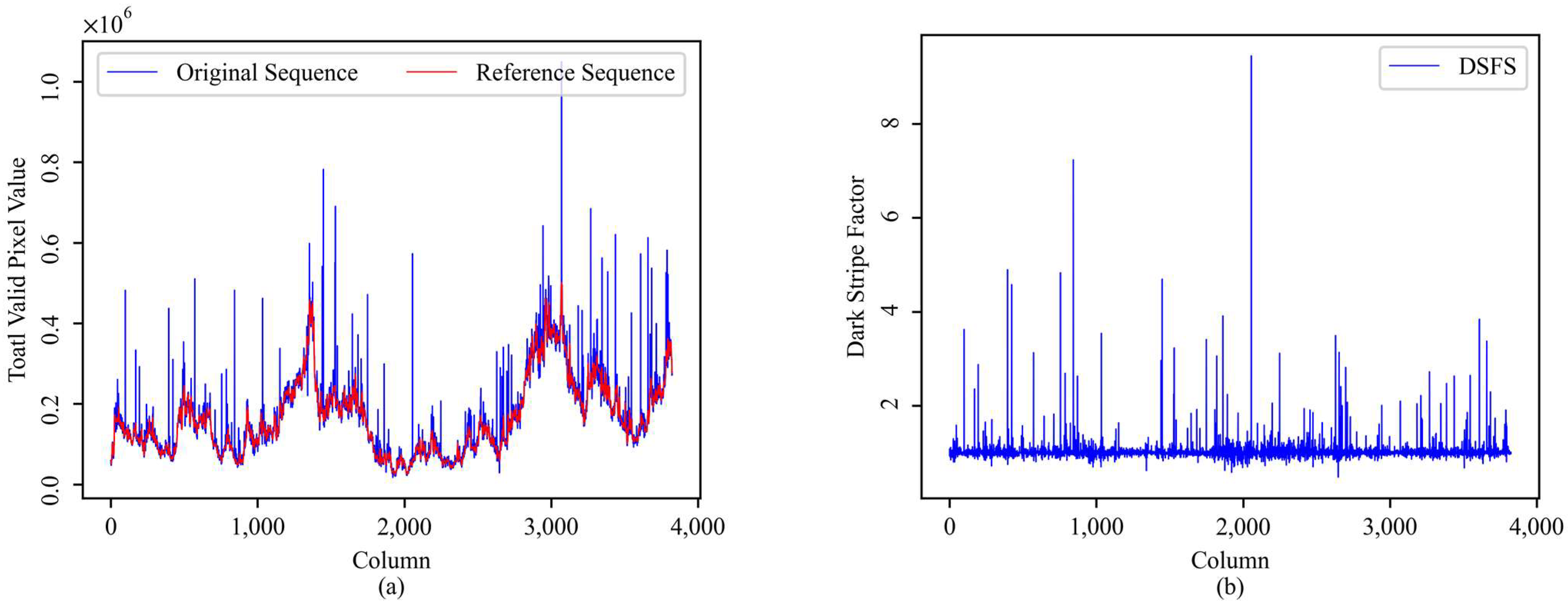
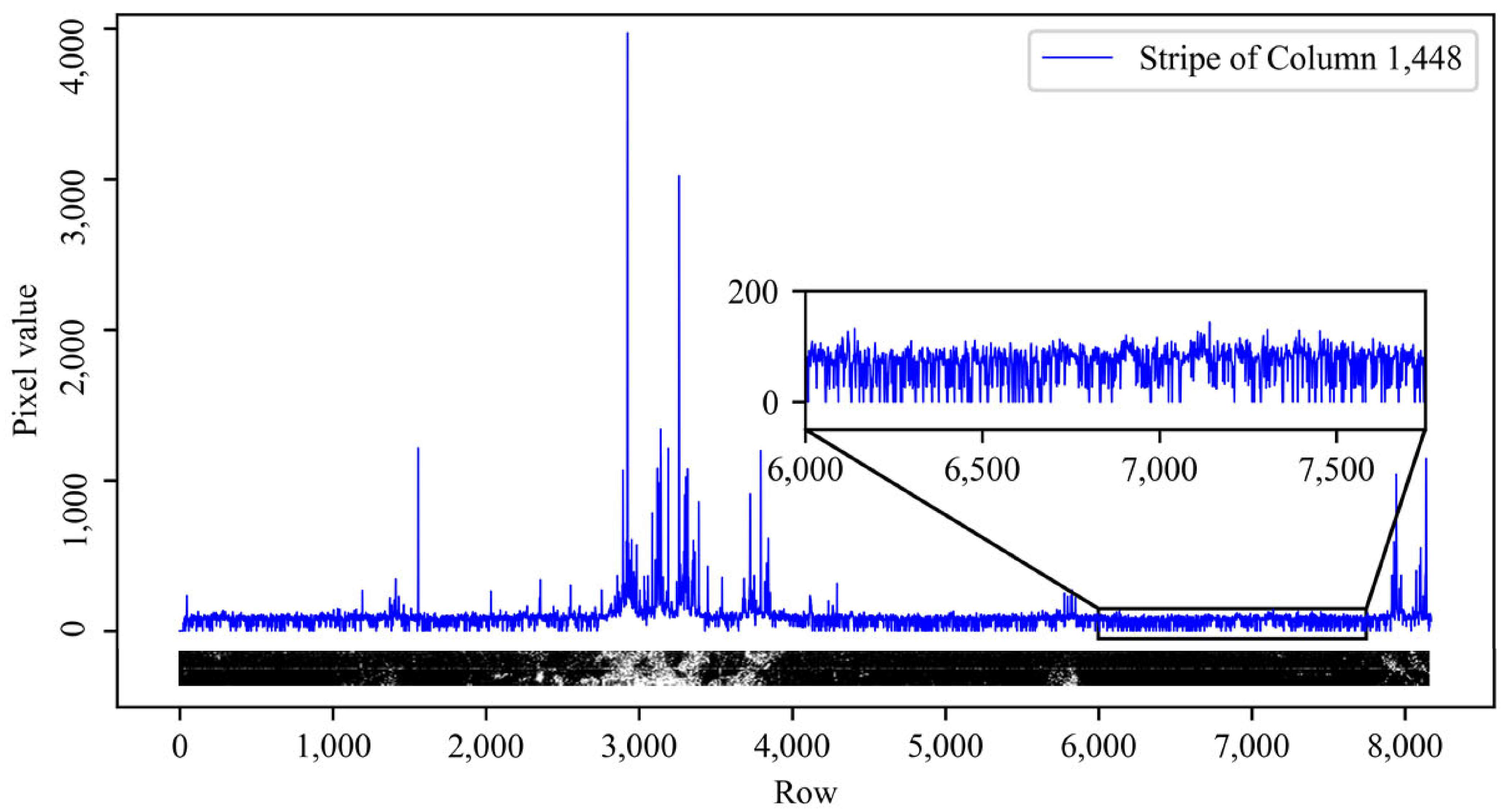
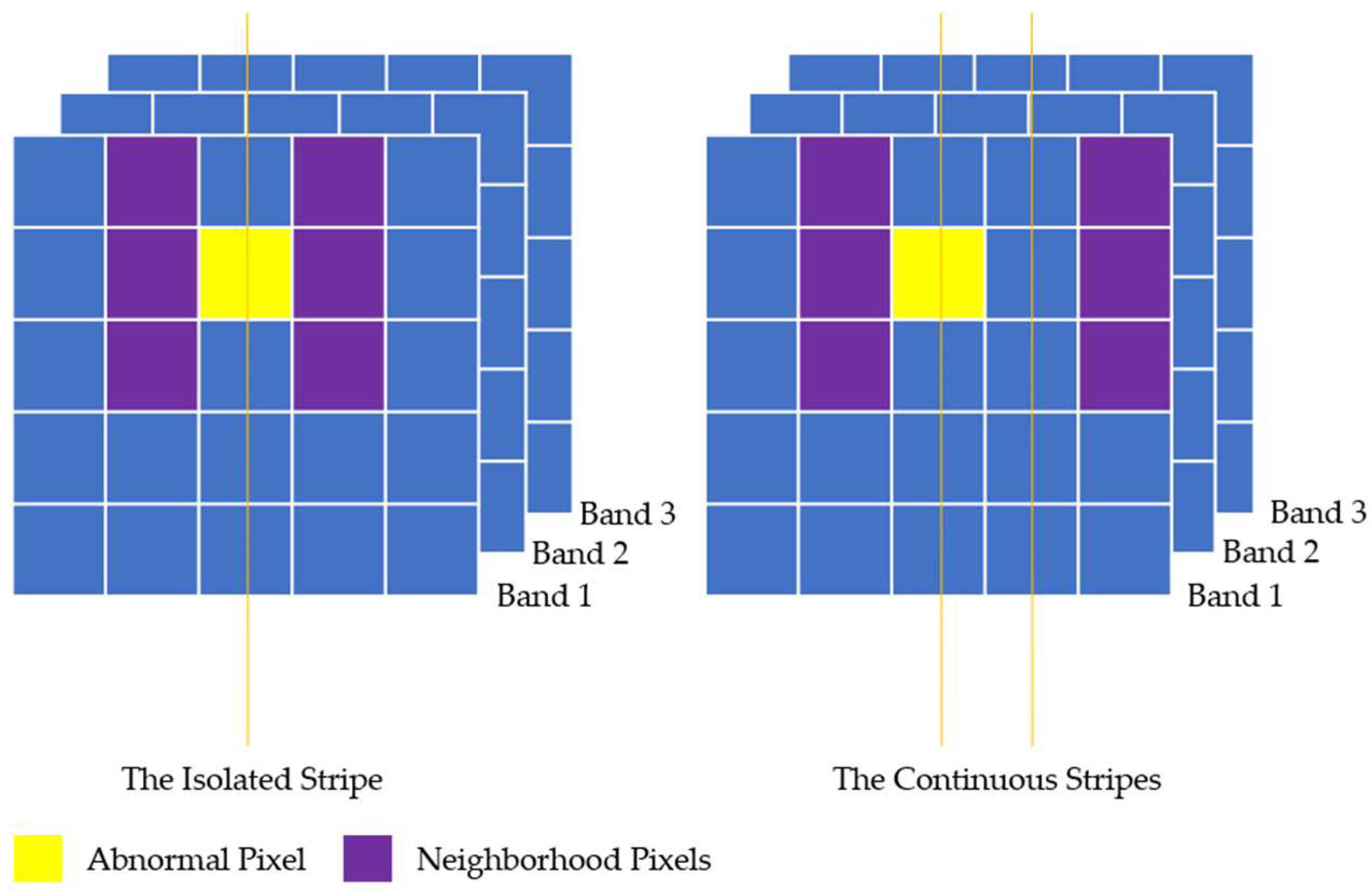
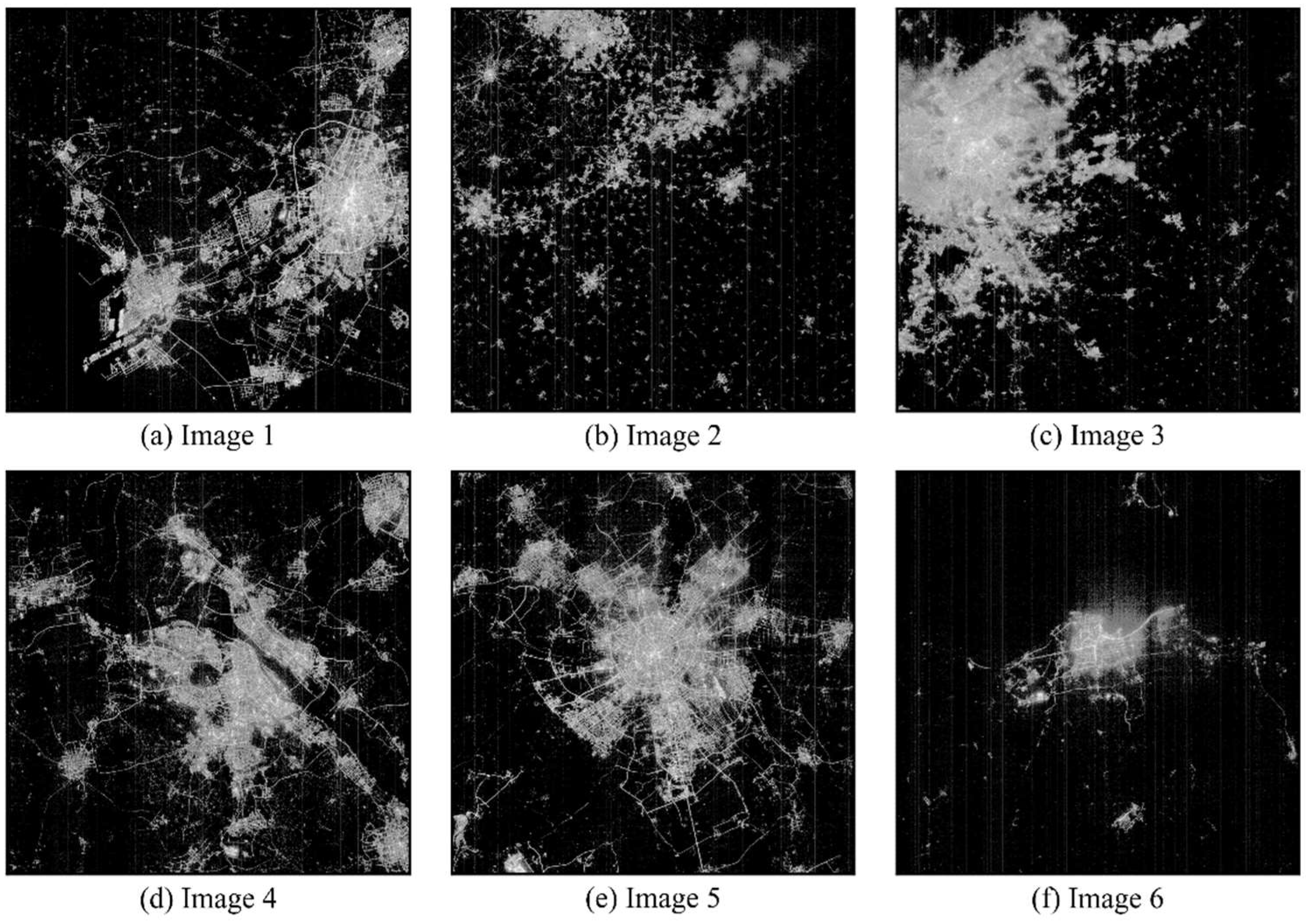
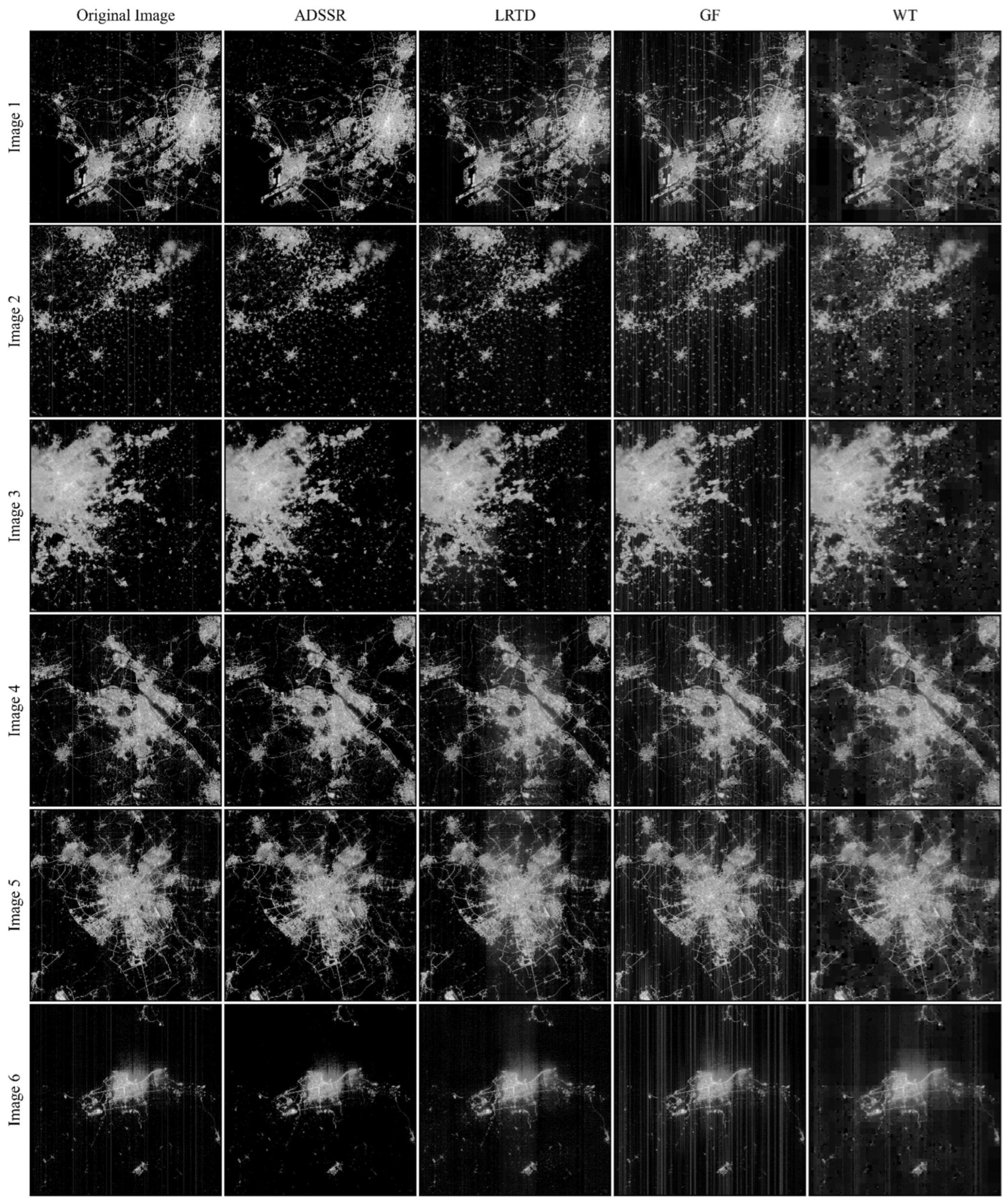
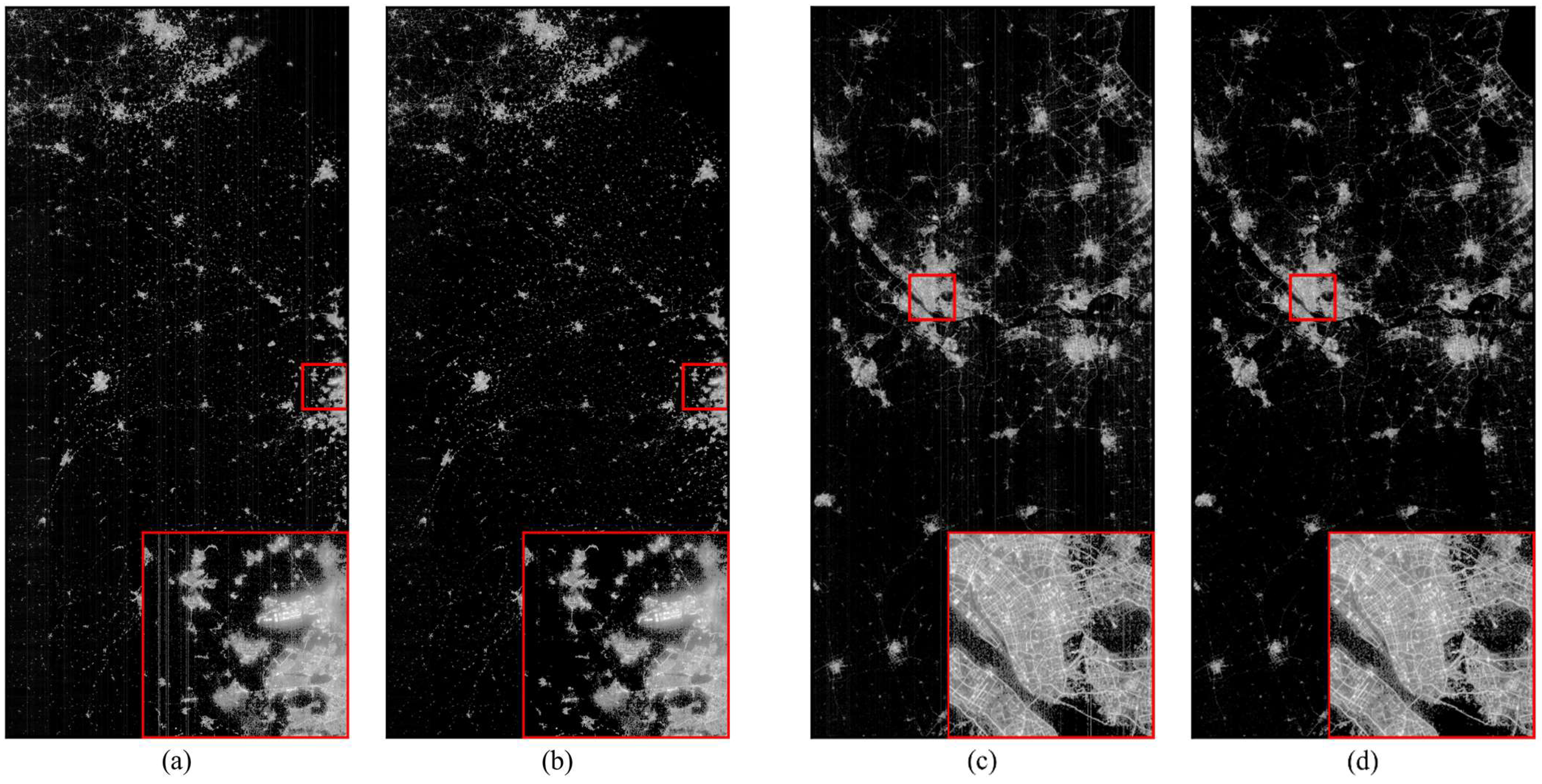
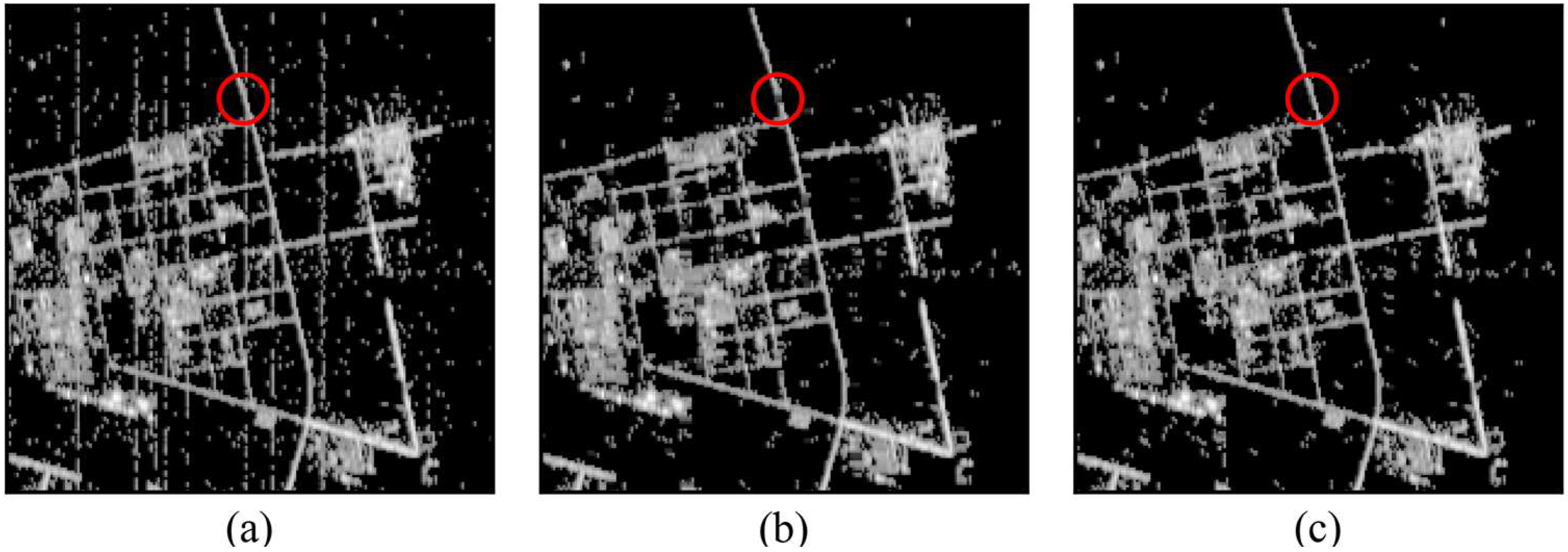
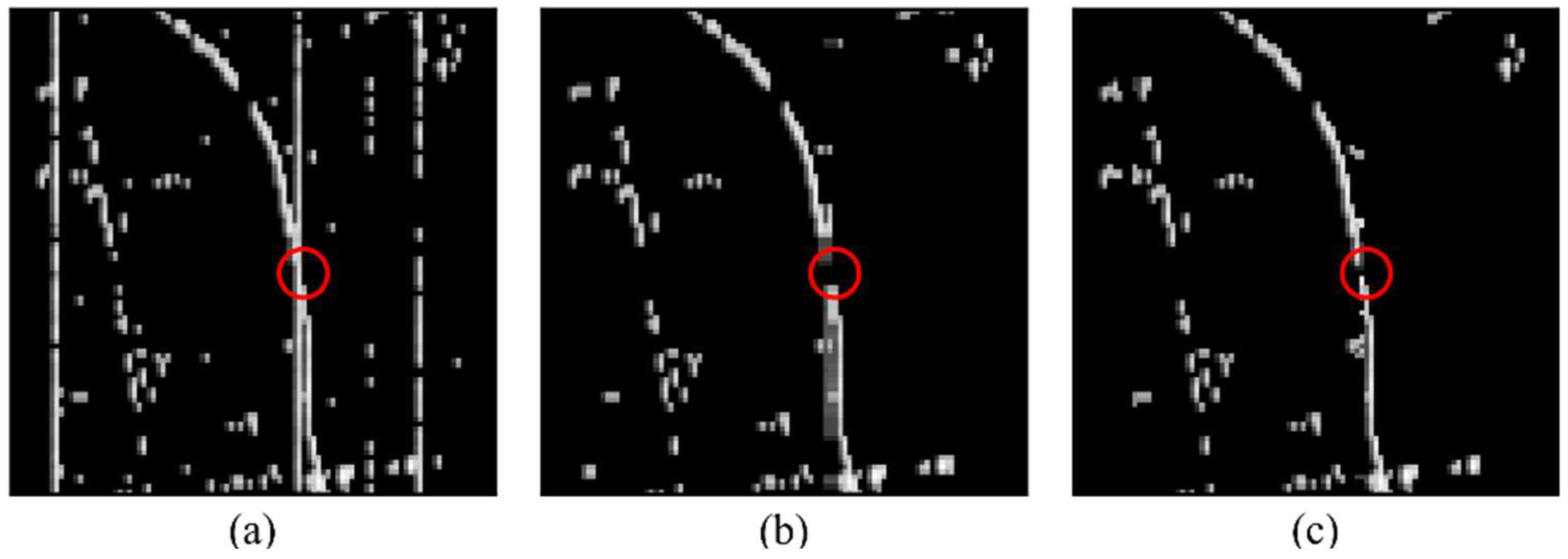
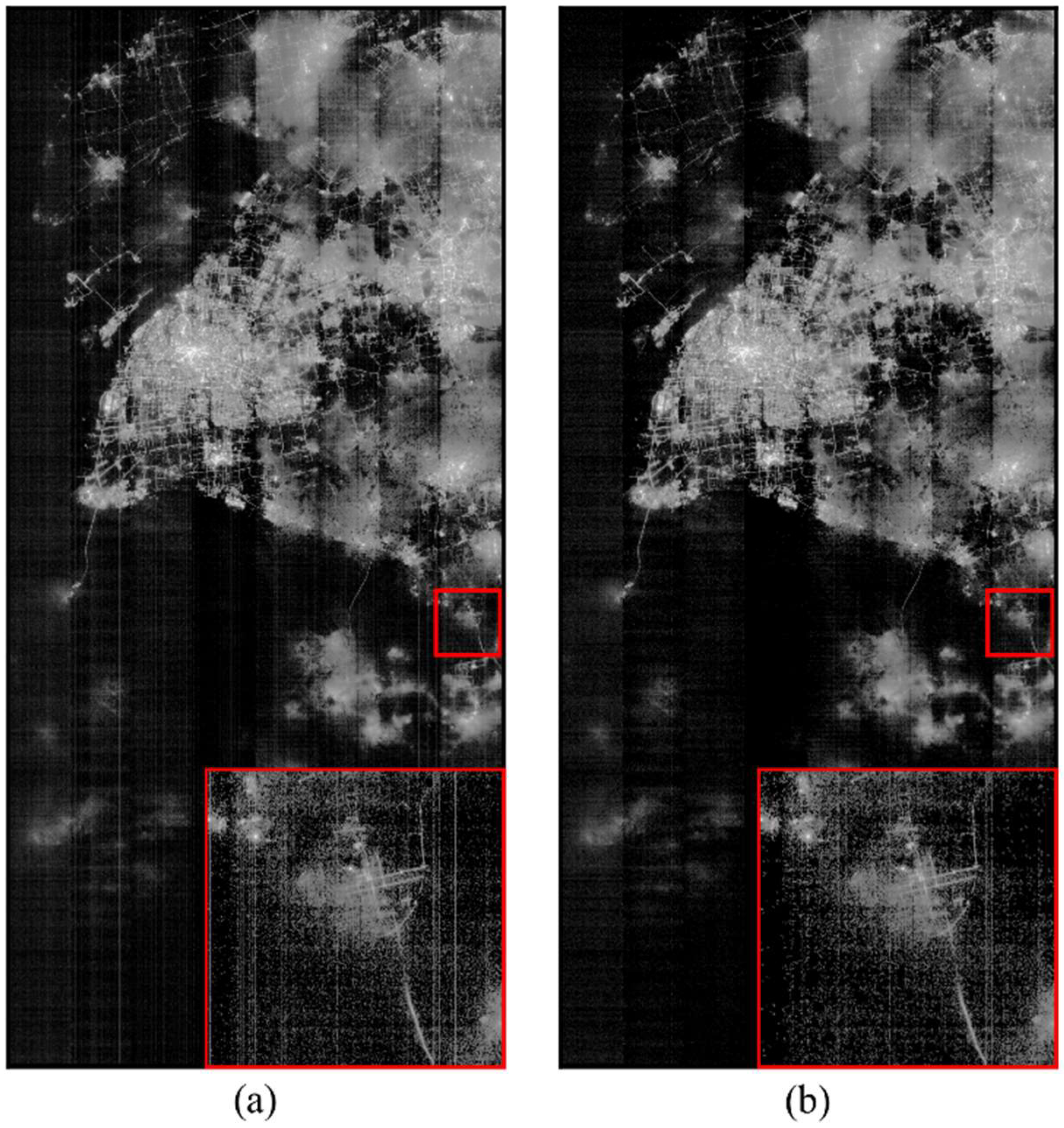
| Sensor | Spatial Resolution (m) | Temporal Resolution | Operational Years | Spectral Bands | Data Accessibility |
|---|---|---|---|---|---|
| DMSP/OLS | ~1000 | 24 h global coverage | 1992 to 2013 | Panchromatic: 400–1100 nm | Free available |
| VIIRS/DNB | ~500 | Daily images can be downloaded | 2011 to present | Panchromatic: 505–890 nm | Free available |
| The International Space Station (ISS) | 5–200 | Irregular image acquisition | 2003 to present | RGB | Free available |
| Luojia1-01 | 130 | The revisiting period is 15 days | 2018 to present | Panchromatic: 460–980 nm | Free available |
| SDGSAT-1/GI | 10 | About 11 to 15 days global coverage | 2021 to present | Panchromatic: 430–900 nm, B: 430–520 nm, G:520–615 nm, R:615–900 nm. | Free available |
| ID | Acquired Date | Position | Image Size | Band | Color Depth (bit) | Resolution (m) |
|---|---|---|---|---|---|---|
| 1 | 3 January 2022 | Tianjin, China | 2000 × 2000 | B1 | 12 | 40 |
| 2 | 5 March 2022 | Lille, France | 2000 × 2000 | B1 | 12 | 40 |
| 3 | 5 March 2022 | Paris, France | 2000 × 2000 | B1 | 12 | 40 |
| 4 | 10 April 2022 | Nanjing, China | 2000 × 2000 | B1 | 12 | 40 |
| 5 | 3 May 2022 | Chengdu, China | 2000 × 2000 | B1 | 12 | 40 |
| 6 | 20 June 2022 | Haikou, China | 2000 × 2000 | B1 | 12 | 40 |
| ID | Acquired Date | Position | Image Size | Band | Color Depth (bit) | Resolution (m) |
|---|---|---|---|---|---|---|
| 1 | 5 March 2022 | 2.52°E 48.94°N | 8175 × 3825 | B1 | 12 | 40 |
| 2 | 10 April 2022 | 123.78°E 40.72°N | 8175 × 3825 | B1 | 12 | 40 |
| Image ID | Evaluator | Original | ADSSR | LRTD | GF | WT |
|---|---|---|---|---|---|---|
| 1 | RNE | 2.4751 | 0.7482 | 2.6064 | 3.2430 | 2.3578 |
| MRD | 0.00% | 0.00% | 0.99% | 4.63% | 8.86% | |
| 2 | RNE | 1.7224 | 0.3647 | 1.5662 | 2.5475 | 1.9063 |
| MRD | 0.00% | 0.00% | 30.02% | 94.47% | 404.28% | |
| 3 | RNE | 1.2347 | 0.4174 | 1.4204 | 2.2791 | 2.0748 |
| MRD | 0.00% | 0.00% | 48.73% | 184.16% | 214.95% | |
| 4 | RNE | 1.2210 | 0.3792 | 1.7996 | 1.9169 | 1.8043 |
| MRD | 0.00% | 0.00% | 2.13% | 4.51% | 12.56% | |
| 5 | RNE | 1.2548 | 0.3897 | 1.2981 | 2.2072 | 1.9454 |
| MRD | 0.00% | 0.46% | 56.84% | 126.38% | 438.62% | |
| 6 | RNE | 1.1040 | 0.4448 | 1.8440 | 2.0815 | 1.4936 |
| MRD | 0.00% | 0.00% | 1.45% | 4.76% | 7.31% |
| ID | Evaluator | Original | Destriped |
|---|---|---|---|
| 1 | RNE | 1.9102 | 0.3792 |
| MRD | 0.00% | 0.00% | |
| 2 | RNE | 1.7676 | 0.0000 |
| MRD | 0.00% | 0.00% |
Publisher’s Note: MDPI stays neutral with regard to jurisdictional claims in published maps and institutional affiliations. |
© 2022 by the authors. Licensee MDPI, Basel, Switzerland. This article is an open access article distributed under the terms and conditions of the Creative Commons Attribution (CC BY) license (https://creativecommons.org/licenses/by/4.0/).
Share and Cite
Zhang, D.; Cheng, B.; Shi, L.; Gao, J.; Long, T.; Chen, B.; Wang, G. A Destriping Algorithm for SDGSAT-1 Nighttime Light Images Based on Anomaly Detection and Spectral Similarity Restoration. Remote Sens. 2022, 14, 5544. https://doi.org/10.3390/rs14215544
Zhang D, Cheng B, Shi L, Gao J, Long T, Chen B, Wang G. A Destriping Algorithm for SDGSAT-1 Nighttime Light Images Based on Anomaly Detection and Spectral Similarity Restoration. Remote Sensing. 2022; 14(21):5544. https://doi.org/10.3390/rs14215544
Chicago/Turabian StyleZhang, Degang, Bo Cheng, Lu Shi, Jie Gao, Tengfei Long, Bo Chen, and Guizhou Wang. 2022. "A Destriping Algorithm for SDGSAT-1 Nighttime Light Images Based on Anomaly Detection and Spectral Similarity Restoration" Remote Sensing 14, no. 21: 5544. https://doi.org/10.3390/rs14215544
APA StyleZhang, D., Cheng, B., Shi, L., Gao, J., Long, T., Chen, B., & Wang, G. (2022). A Destriping Algorithm for SDGSAT-1 Nighttime Light Images Based on Anomaly Detection and Spectral Similarity Restoration. Remote Sensing, 14(21), 5544. https://doi.org/10.3390/rs14215544








